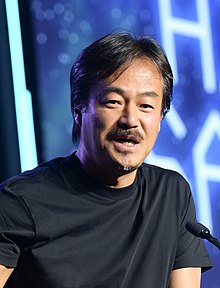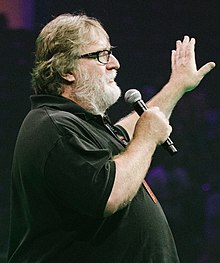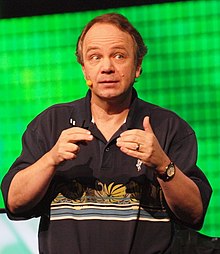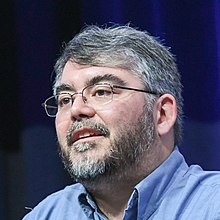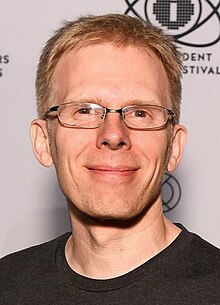Portal:Video games
Portal maintenance status: (April 2019)
|
The Video Games Portal

A video game, also known as a computer game or just a game, is an electronic game that involves interaction with a user interface or input device (such as a joystick, controller, keyboard, or motion sensing device) to generate visual feedback from a display device, most commonly shown in a video format on a television set, computer monitor, flat-panel display or touchscreen on handheld devices, or a virtual reality headset. Most modern video games are audiovisual, with audio complement delivered through speakers or headphones, and sometimes also with other types of sensory feedback (e.g., haptic technology that provides tactile sensations). Some video games also allow microphone and webcam inputs for in-game chatting and livestreaming.
Video games are typically categorized according to their hardware platform, which traditionally includes arcade video games, console games, and computer (PC) games; the latter also encompasses LAN games, online games, and browser games. More recently, the video game industry has expanded onto mobile gaming through mobile devices (such as smartphones and tablet computers), virtual and augmented reality systems, and remote cloud gaming. Video games are also classified into a wide range of genres based on their style of gameplay and target audience. (Full article...)
Featured articles – load new batch
-
Image 1Ōkami is a 2006 action-adventure game developed by Clover Studio and published by Capcom. It was released for PlayStation 2 in 2006 in Japan and North America, and in 2007 in Europe and Australia. After the closure of Clover Studio a few months after the release, a port for Wii was developed by Ready at Dawn, Tose, and Capcom, and released in 2008.
Set in a fictional version of classical Japan, Ōkami combines Japanese mythology and folklore to tell the story of how the land was saved from darkness by the Shinto sun goddess Amaterasu, who took the form of a white wolf. It features a sumi-e-inspired cel-shaded visual style and the Celestial Brush, a gesture-system to perform miracles. The game was planned to use more traditional realistic rendering, but this had put a strain on the graphics processing of the PlayStation 2. Clover Studio switched to a cel-shaded style to reduce the processing, which led to the Celestial Brush concept. The gameplay is modeled on The Legend of Zelda, one of director Hideki Kamiya's favorite series. The game's name is a pun, as "ōkami" can mean either "great god" (大神) or "wolf" (狼) in Japanese.
Ōkami was one of the last PlayStation 2 games released prior to the release of the PlayStation 3. Although it suffered from poor sales, the game received critical acclaim, earning IGN's 2006 Game of the Year. The Wii version earned similar praise, though the motion control scheme received mixed reviews. A high-definition port, remastered by Capcom and HexaDrive, was released on the PlayStation 3 via the PlayStation Network in October 2012 and for retail in Japan in November, supporting the use of the PlayStation Move motion controller. The port was released for PlayStation 4, Windows, and Xbox One in December 2017 worldwide, for the Nintendo Switch in August 2018, and for Amazon Luna in April 2022. Mainstream adoption of the game has improved with the release of these remasters, and Ōkami is considered to be one of the best video games ever made, as well as an example of video games as an art form, aided by the improved art details and graphics resolutions. (Full article...) -
Image 2Tidus (Japanese: ティーダ, Hepburn: Tīda) is a fictional character in Square Enix's video game series Final Fantasy and the main protagonist of the 2001 role-playing video game Final Fantasy X. Tidus is a 17-year-old athlete from the city of Zanarkand who is transported to the world of Spira following an attack by a massive creature known as Sin. Shortly after his arrival there, Tidus meets a summoner called Yuna and her guardians, and joins her in a pilgrimage to kill Sin after learning the creature is his missing father, Jecht. Tidus has appeared in other video games, including the Final Fantasy X sequel X-2, where his belonging remains unknown but can be recruited as a playable character in the international version. He is also present as a child in the Kingdom Hearts series and as alternate takes in several Square Enix crossover games.
Tetsuya Nomura designed Tidus with a cheerful appearance that contrasts with previous Final Fantasy protagonists. Scenario writer Kazushige Nojima wanted to expand the relationship between player and character with monologues that describe the game's setting. The narrative was initially focused on the romance between Tidus and Yuna, but Square Enix decided the main focus would be on Tidus's relationship with Jecht to provide a major impact in the setting. Tidus is voiced primarily by Masakazu Morita in Japanese and James Arnold Taylor in English; both actors enjoyed voicing the character, and Morita also performed his motion capture.
Tidus has been generally well-received by video-game critics. Tidus' cheerful personality and heroism make him an appealing protagonist, contrasting with previous male characters in the franchise and being comparable to messiah figures and other fictional heroes. Tidus's character development and romantic relationship with Yuna are considered among the best in video games, although reviewers and fans were divided on Taylor's voicing. Tidus has been popular with fans, often ranking in polls as one of the best Final Fantasy characters. Action figures and Tidus-related jewelry have been produced, and he is a popular character among cosplayers. (Full article...) -
Image 3Cloud is a 2005 puzzle video game developed by a team of students in the University of Southern California's (USC) Interactive Media Program. The team began development of the game for Microsoft Windows in January 2005 with a US$20,000 grant from the USC Game Innovation Lab; the game was released as a free download that October. By July 2006, the hosting website had received 6 million visits, and the game had been downloaded 600,000 times.
The game centers on a boy who dreams of flying while asleep in a hospital bed. The concept was partially based on lead designer Jenova Chen's childhood; he was often hospitalized for asthma and would daydream while alone in his room. Assuming the role of the boy, the player flies through a dream world and manipulates clouds to solve puzzles. The game was intended to spark emotions in the player that the video game industry usually ignored.
Cloud won the Best Student Philosophy award at the 2006 Slamdance Guerrilla Games Competition, and a Student Showcase award at the 2006 Independent Games Festival. The game was received well by critics, who cited its visuals, music, and relaxing atmosphere as high points. Chen and producer Kellee Santiago went on to co-found the studio Thatgamecompany, which has considered remaking Cloud as a commercial video game. (Full article...) -
Image 4Populous: The Beginning is a real-time strategy video game and the third entry in the Populous series, developed by Bullfrog Productions. The game was released in 1998 on Microsoft Windows, and in 1999 for the PlayStation. Unlike earlier games in the series, which cast the player in the role of a god influencing loyal followers, The Beginning took a radical departure and placed the player in the role of a shaman, who directly leads her tribe against opponents. Throughout the twenty-five missions of the campaign, the player leads their tribe across a solar system, dominating enemy tribes and tapping new sources of magic, with the ultimate goal of the shaman attaining godhood herself.
Populous: The Beginning was the first entry in the series to use 3D computer graphics; Bullfrog waited four years after Populous II: Trials of the Olympian Gods so that the graphics technology could catch up to their vision for a new and different game in the series. The developers considered the addition of terrain deformation and manipulation, combined with "smart" villagers who automatically attended to tasks, to add an entirely new dimension to the series. The game's original title was Populous: The Third Coming before being changed prior to the beta release.
Populous: The Beginning plays very differently from earlier titles and received mixed reviews. Critics noted the excellent graphics, while complaints were directed at the artificial intelligence and the indecision in game design between being a real time strategy title and a god game. GamePro's Peter Olafson wrote that Populous: The Beginning was a good game but was "without a quintessential quality that defined Populous." (Full article...) -
Image 5Planescape: Torment is a 1999 role-playing video game developed by Black Isle Studios and published by Interplay Entertainment for Windows. The game takes place in locations from the multiverse of Planescape, a Dungeons & Dragons (D&D) fantasy campaign setting. The game's engine is a modified version of the Infinity Engine, which was used for BioWare's Baldur's Gate, a previous D&D game set in the Forgotten Realms.
Planescape: Torment is primarily story-driven, with combat taking a secondary role. The protagonist, known as The Nameless One, is an immortal man who forgets everything if killed. The game focuses on his journey through the city of Sigil and other planes to reclaim his memories of previous lives, and to discover why he was made immortal in the first place. Several characters in the game may join The Nameless One on his journey; most of these characters have encountered him in the past or have been influenced by his actions in some way.
The game was not a commercial success, but it received critical acclaim and has since become a cult classic, claimed by video game journalists to be the best role-playing video game of 1999. It was lauded for its immersive dialogue, for the dark and relatively obscure Planescape setting, and for the protagonist's unique persona, which shirked many characteristics of traditional role-playing games. It is commonly cited as one of the greatest video games of all time. An enhanced version for modern platforms was made by Beamdog and released for Windows, Linux, macOS, Android, and iOS in April 2017 and for Nintendo Switch, PlayStation 4, and Xbox One in October 2019. (Full article...) -
Image 6Defense of the Ancients (DotA) is a multiplayer online battle arena (MOBA) mod for the video game Warcraft III: Reign of Chaos (2002) and its expansion, The Frozen Throne (2003). The objective of the game is for each team to destroy their opponents' Ancient, a heavily guarded structure at the opposing corner of the map. Players use powerful units known as heroes, and are assisted by allied teammates and AI-controlled fighters. As in role-playing games, players level up their heroes and use gold to buy equipment during the game.
DotA has its roots in the "Aeon of Strife" custom map for StarCraft. The scenario was developed with the World Editor of Reign of Chaos, and was updated upon the release of its expansion, The Frozen Throne. There have been many variations of the original concept, the most popular being DotA Allstars, eventually simplified to DotA. The mod has been maintained by several authors during development, with the pseudonymous designer known as IceFrog maintaining the game since the mid-2000s.
DotA became a feature at several worldwide tournaments, including Blizzard Entertainment's BlizzCon and the World Cyber Games. Critical reception to DotA was positive, and it has been called one of the most popular mods of any game. DotA is largely attributed as being the most significant inspiration for the MOBA genre. American video game developer Valve acquired the intellectual property rights to DotA in 2009 to develop a franchise, beginning with Dota 2 in 2013. (Full article...) -
Image 7Smash Hit is a 2014 rail shooter game developed and published by the Swedish indie game studio Mediocre. Through the game's 11 levels, the player takes a first-person perspective, shooting metal balls to destroy glass obstacles. Additionally, the player can increase their rate of fire by smashing a consecutive sequence of crystals and gather power-ups that are activated for a limited amount of time. The game also features a one-time in-game purchase that allows the player to start from any unlocked checkpoint.
The game's development began in 2012. Dennis Gustafsson programmed the game and created its physics engine and acoustics, while Henrik Johansson designed its levels. Douglas Holmquist was hired to compose the soundtrack and sound effects. The game was released for free on iOS and Android on 6 March 2014. A virtual reality adaptation of the game was released for platforms in 2015 and 2018. Smash Hit received positive acclaim from reviewers, who praised its physics engine, graphics, music, and sound effects. CNET and Apple Inc. listed it as one of the best mobile games of 2014. After Mediocre closed in 2017, Gustafsson and Holmquist worked on the 2022 video game Teardown, which incorporated unused sounds from Smash Hit. (Full article...) -
Image 8Sinistar: Unleashed is a 1999 action space shooter video game for Microsoft Windows. It was designed by Marc Michalik and Walter Wright and developed at GameFX, a small studio composed of former members of Looking Glass Studios. Originally titled Out of the Void, development of the project began in 1997 and had no relationship with the Sinistar franchise. After licensing the franchise from Midway Games that year, GameFX shifted the focus of the game and developed it as a sequel to the original Sinistar, which was released by Williams in 1982.
Like the previous installment, Sinistar: Unleashed focuses on the destruction of the Sinistar, a large bio-mechanical machine, powered by machines called the Sporg. To achieve this goal, the player has a variety of starships, power-ups and weapons. Unlike its predecessor, the game has full three-dimensional graphics and a wider control scheme. Sinistar: Unleashed features 29 levels, five of which are hidden; each level has a Sinistar.
Sinistar: Unleashed received mixed reception when released. Critics lauded its audacity, as well as the addition of new features into the game. Several journalists felt that GameFX captured all the elements that represented a Sinistar game and stayed true to the franchise by feeling familiar to fans of the original game. However, critics faulted the boss designs and the repetitiveness of the gameplay. (Full article...) -
Image 9BioShock 2 is a first-person shooter video game developed by 2K Marin and published by 2K Games. It was released worldwide for PlayStation 3, Windows, and Xbox 360 on February 9, 2010; Feral Interactive released an OS X version on March 30, 2012. The game takes place in the dystopian underwater city of Rapture, eight years after the events of BioShock. In the single-player campaign, players control the armored protagonist Subject Delta as he fights through Splicers—the psychotic human population of the city—using weapons and an array of genetic modifications. The game includes a story-driven multiplayer mode that takes place before the events of BioShock, during Rapture's civil war.
After the success of BioShock, 2K Games formed a new studio, 2K Marin, to create the sequel. 2K Australia, Arkane Studios, and Digital Extremes provided additional support. The developers focused on improving gameplay elements from the first game, and return to the Rapture setting to explore a new perspective of the city. The story received major changes throughout development. Garry Schyman, who composed BioShock's soundtrack, returned for the sequel; he expanded the game's sonic palette to include more blues and religious music to parallel its themes.
BioShock 2 received positive reviews, with praise directed at its narrative, themes, art style, characters, endings and gameplay. Criticisms included a slow start and failure to distinguish itself from its predecessor. Retrospective reviews have been more positive, with some considering it the best in the series. The multiplayer mode was supported with downloadable content, and a single-player campaign expansion, Minerva's Den, released in August 2010. The game sold more than 3 million copies, but did not meet the publisher's sales expectations. A remastered version titled BioShock 2 Remastered was released as part of BioShock: The Collection for PlayStation 4, Windows, Xbox One, and Nintendo Switch. (Full article...) -
Image 10Final Fantasy XIII-2 is a role-playing video game developed and published by Square Enix for the PlayStation 3 and Xbox 360. It was released in 2011 in Japan and 2012 in North America and PAL regions, and was ported to Windows in 2014. XIII-2 is a direct sequel to the 2009 role-playing game Final Fantasy XIII and part of the Fabula Nova Crystallis subseries. It includes modified features from the previous game, including fast-paced combat and a customizable "Paradigm" system to control which abilities are used by the characters, and adds a new system that allows monsters to be captured and used in battle. The game's plot features a heavy time travel element, allowing the player to jump between different times at the same location or different places at the same time. Lightning, the protagonist of the original game, has disappeared into an unknown world. Her younger sister Serah Farron and Noel Kreiss journey through time in an attempt to find her.
Development of Final Fantasy XIII-2 began in early 2010 and lasted about one and a half years. The game was unveiled at the Square Enix 1st Production Department Premier in January 2011. Many of the key designers remained in their roles from the previous game, and developer tri-Ace was hired to help with the game's design, art, and programming. The development team wanted to exceed Final Fantasy XIII in every aspect while making the story's tone more dark and mysterious than the previous game. The game builds upon the Paradigm Shift battle system used in XIII and includes a less linear overall design.
Final Fantasy XIII-2 received critical acclaim in Japan and generally positive reviews from Western video game journalists. Though praised for its gameplay, lack of linearity, and graphics, the game's story was criticized as weak and confusing. The game was the fifth-best selling game of 2011 in Japan, and sold 3.1 million copies worldwide by January 2013. A sequel, Lightning Returns: Final Fantasy XIII, was released in 2013 in Japan and 2014 worldwide. (Full article...)
Did you know... - show different entries
- ... that fighting video game Panza Kick Boxing was endorsed by a French kickboxing champion who also supplied technical advice?
- ... that a reviewer thought that the video game Robbery Bob contained cringeworthy dialogue?
- ... that Terra Invicta's development company is a group of former volunteer video game modders that decided to release their own game after the success of their mod?
- ... that the name of the video game mod series Bomba Patch was inspired by éclairs?
- ... that LittleBigPlanet, a video game that allows the player to create levels, coincided with the rise of user-generated content?
- ... that deceased YouTuber Technoblade beat the video game Minecraft in hardcore mode using a racing-wheel controller?
- ... that the success of Kingdom Rush prompted plans to grow the video game industry of Uruguay?
- ... that a cheat code in the video game Spyro: Year of the Dragon grants access to a near-complete copy of Crash Bash?
- ... that Justin Yu, the current Classic Tetris World Champion, is also a cellist in MIT's video game orchestra?
- ... that Rockstar Vienna was the largest video game developer in Austria when it closed in 2006?
- ... that the science-fiction video game The Anacrusis is named after a musical term?
- ... that the character Psycho Mantis in the video game Metal Gear Solid breaks the fourth wall by identifying the player's other games?
Selected biography – load new batch
-
Image 1Satoshi Tajiri (Japanese: 田尻 智, Hepburn: Tajiri Satoshi, born August 28, 1965) is a Japanese video game designer and director who is the creator of the Pokémon franchise and the co-founder and president of video game developer Game Freak.
A fan of arcade games in his youth, Tajiri wrote for and edited his own video gaming fanzine Game Freak with Ken Sugimori, before evolving it into a development company of the same name. Tajiri claims that the joining of two Game Boys via a link cable inspired him to create a game which embodied the collection and companionship of his childhood hobby, insect collecting. The game, which became Pokémon Red and Pokémon Green, took six years to complete and went on to spark a multibillion-dollar franchise which reinvigorated Nintendo's handheld gaming scene. Tajiri continued to work as director for the Pokémon series until the development of Pokémon Ruby and Sapphire, when he changed his role to executive producer, which he holds to this day. (Full article...) -
Image 2
Jennifer Hale is a Canadian-born American voice actress. She is best known for her work in video game franchises such as Baldur's Gate, Mass Effect, Metal Gear Solid, BioShock Infinite, Metroid Prime, Halo, Overwatch, and Star Wars: Knights of the Old Republic. In 2013, she was recognized by Guinness World Records as the most prolific video game voice actor.
Hale is featured in animation such as The Real Adventures of Jonny Quest, The Powerpuff Girls, Codename: Kids Next Door, The Grim Adventures of Billy & Mandy, Brandy & Mr. Whiskers, Totally Spies!, Avatar: The Last Airbender and its continuation The Legend of Korra, Where on Earth Is Carmen Sandiego? and Star Wars: The Clone Wars. She also voices Thorn of the Hex Girls in various Scooby-Doo movies and TV episodes, as well as Cinderella and Princess Aurora in various Disney Princess media of the 2000s and 2010s. She is also known for voicing Jean Grey in a variety of Marvel media, most recently in X-Men '97. (Full article...) -
Image 3
Felix Arvid Ulf Kjellberg (/ˈʃɛlbɜːrɡ/ SHEL-burg, Swedish: [ˈfěːlɪks ˈǎrːvɪd ɵlf ˈɕɛ̂lːbærj] ⓘ; born 24 October 1989), better known as PewDiePie (/ˈpjuːdiːpaɪ/ PEW-dee-py), is a Swedish YouTuber known for his comedic videos. Kjellberg's popularity on YouTube and extensive media coverage has made him one of the most noted online personalities and content creators. He has been portrayed in media as a figurehead for YouTube, especially in the genre of gaming.
Born and raised in Gothenburg, Kjellberg registered his YouTube channel "PewDiePie" in 2010, primarily posting Let's Play videos of horror and action video games. His channel gained a substantial following and was one of the fastest growing channels in 2012 and 2013, before becoming the most-subscribed on YouTube on 15 August 2013. From 29 December 2014 to 14 February 2017, Kjellberg's channel was also the most-viewed on the platform. During this period, his content shifted focus from Let's Plays and diversified to include vlogs, comedy shorts, formatted shows, and music videos. (Full article...) -
Image 4
Lim Yo-hwan (Korean: 임요환; Hanja: 林遙煥, born September 4, 1980), known online as SlayerS_'BoxeR' (usually shortened to BoxeR), is a former professional player of the real-time strategy computer game StarCraft. He is often referred to as The Terran Emperor, or simply The Emperor, and is widely considered to be one of the most successful players of the genre as well as a pop culture icon.
Lim won his first StarCraft: Brood War tournament in 1999. From 2001 to 2002, he won multiple major championships, including two OnGameNet Starleague titles and two World Cyber Games gold medals. In 2002, he also created the team Team Orion, which later became SK Telecom T1 (SKT T1) in 2004. He began his compulsory military service in 2006, where he played on South Korea's newly formed Air Force esports team Airforce Challenge E-sports. In late 2010, he retired from StarCraft: Brood War and founded the StarCraft II team SlayerS. He then briefly returned to SKT T1 as a coach in 2012 before retiring due to health related issues. Lim finished his playing career with a record of 603 wins and 430 losses (58.4%). (Full article...) -
Image 5Hironobu Sakaguchi (坂口 博信, Sakaguchi Hironobu, born November 25, 1962) is a Japanese game designer, director, producer, and writer. Originally working for Square (later Square Enix) from 1983 to 2003, he departed the company and founded independent studio Mistwalker in 2004. He is known as the creator of the Final Fantasy franchise, in addition to other titles during his time at Square. At Mistwalker, he is known for creating the Blue Dragon and Terra Battle series among several standalone titles, moving away from home consoles and creating titles for mobile platforms.Sakaguchi at the 2015 Game Developers Choice Awards
Originally intending to become a musician, he briefly studied electronics and programming, joining Square as a part-time employee, then later a full-time employee when Square became an independent company in 1986. He led the development of several titles before helping to create the original Final Fantasy, which proved highly successful and cemented his status within the company. Following the financial failure of Final Fantasy: The Spirits Within, his debut as a film director, Sakaguchi withdrew from Square's management and eventually resigned in 2003. He continued his game career through Mistwalker, first co-developing projects through external partners and then smaller in-studio mobile projects. (Full article...) -
Image 6
Mark Edward Fischbach (/ˈfɪʃˌbɑːk/ FISH-bahk; born June 28, 1989), known online as Markiplier, is an American YouTuber, actor and filmmaker. One of the most popular YouTubers on the platform, he is known for his "Let's Play" videos of indie horror games. He was listed by Forbes as the third highest-paid content creator on the platform in 2022, and has won four Streamy Awards and a Golden Joystick Award. He has spun-off his YouTube fame into a media career, venturing into acting and filmmaking.
After joining YouTube in 2012, Fischbach became popular on the platform with Let's Plays of Amnesia: The Dark Descent (2010) and the Five Nights at Freddy's series; as of 2024, his channel had over 37 million subscribers. He signed with talent agency William Morris Endeavor in 2016. While with the agency, he released a clothing line, wrote and directed the YouTube Original series A Heist with Markiplier (2019) and In Space with Markiplier (2022), and hosted or co-hosted two podcasts which reached No. 1 on Spotify. (Full article...) -
Image 7
Gabe Logan Newell (born November 3, 1962), also known by his nickname Gaben, is an American businessman who is the president and co-founder of the video game company Valve Corporation.
Newell was born in Colorado and grew up in Davis, California. He attended Harvard University in the early 1980s but dropped out to join Microsoft, where he helped create the first versions of the Windows operating system. In 1996, he and another employee, Mike Harrington, left Microsoft to found Valve and fund the development of their first game, Half-Life (1998). Harrington left in 2000. (Full article...) -
Image 8
Nolan Kay Bushnell (born February 5, 1943) is an American businessman and electrical engineer. He established Atari, Inc. and the Chuck E. Cheese's Pizza Time Theatre chain. He has been inducted into the Video Game Hall of Fame and the Consumer Electronics Association Hall of Fame, received the BAFTA Fellowship and the Nations Restaurant News "Innovator of the Year" award, and was named one of Newsweek's "50 Men Who Changed America". He has started more than 20 companies and is one of the founding fathers of the video game industry. He is on the board of Anti-Aging Games. In 2012, he founded an educational software company called Brainrush, that is using video game technology in educational software.
He is credited with Bushnell's Law, an aphorism about games that are "easy to learn and difficult to master" being rewarding. (Full article...) -
Image 9Ken Kutaragi (久夛良木 健, Kutaragi Ken, born 2 August 1950) is a Japanese engineering technologist and businessman. He is the former chairman and CEO of Sony Interactive Entertainment (SIE), the video game division of Sony Group Corporation, and current president and CEO of Cyber AI Entertainment. He is known as "The Father of the PlayStation", as he oversaw the development of the original console and its successors and spinoffs, including the PlayStation 2, PlayStation Portable, and the PlayStation 3. He departed Sony in 2007, a year after the PlayStation 3 was released.Kutaragi with his Lifetime Achievement Award at the Game Developers Choice Awards 2014
He had also designed the sound processor for the Super Nintendo Entertainment System. With Sony, he designed the VLSI chip which works in conjunction with the PS1's RISC CPU to handle the graphics rendering. (Full article...) -
Image 10
Anita Sarkeesian (/sɑːrˈkiːziən/ sar-KEE-zee-ən; born 1983) is a Canadian-American feminist media critic. She is the founder of Feminist Frequency, a website that hosts videos and commentary analyzing portrayals of women in popular culture. Her video series Tropes vs. Women in Video Games, examines tropes in the depiction of female video game characters.
Media scholar Soraya Murray calls Sarkeesian emblematic of "a burgeoning organized feminist critique" of stereotyped and objectified portrayals of women in video games.
In 2012, Sarkeesian was targeted by an online harassment campaign following her launch of a Kickstarter project to fund the Tropes vs. Women in Video Games series. The threats and harassment generated widespread media attention, and resulted in the project far exceeding its funding goal. The media coverage placed Sarkeesian at the center of discussions about misogyny in video game culture and online harassment. She has spoken to TEDxWomen, XOXO Festival, and the United Nations' Broadband Working Group on Gender, and appeared on The Colbert Report discussing her experiences of harassment and the challenge of attempting to improve gender inclusivity in gaming culture and the media. (Full article...) -
Image 11Koji Kondo (Japanese: 近藤 浩治, Hepburn: Kondō Kōji, August 13, 1961) is a Japanese composer and pianist at the video game company Nintendo. He is best known for his contributions for the Super Mario and The Legend of Zelda series, with his Super Mario Bros. theme being the first piece of music from a video game included in the American National Recording Registry. Kondo was hired by Nintendo in 1984 as their first dedicated composer and is currently a senior executive within their Entertainment Planning & Development division. (Full article...)
-
Image 12Shinji Mikami (三上 真司, Mikami Shinji, born August 11, 1965) is a Japanese video game designer, director, and producer. Starting his career at Capcom in 1990, he has worked on many of the company's most successful games. He directed the first installment of the Resident Evil series in 1996 and the first installment of the Dino Crisis series in 1999, both survival horror games. He returned to Resident Evil to direct the remake of the first game in 2002 and the survival horror third-person shooter Resident Evil 4 in 2005. In 2006, he directed his final Capcom game God Hand, a beat 'em up action game. Mikami founded PlatinumGames in 2006 and directed the third-person shooter Vanquish in 2010. That same year he left the studio and founded a new studio Tango Gameworks and directed the survival horror game The Evil Within in 2014. He has also served the roles of producer and executive producer for many games. In 2023, he left the studio and founded a new studio KAMUY in 2024.
In 2009, he was chosen by IGN as one of the top 100 game creators of all time. (Full article...) -
Image 13Nobuo Uematsu (植松 伸夫, Uematsu Nobuo, born March 21, 1959) is a Japanese composer and keyboardist best known for his contributions to the Final Fantasy video game series by Square Enix. A self-taught musician, he began playing the piano at the age of twelve, with English singer-songwriter Elton John as one of his biggest influences in pursuing a musical career.
Uematsu joined Square in 1986, where he first met Final Fantasy creator Hironobu Sakaguchi. The two later worked together on many games at the company, most notably in the Final Fantasy series. After nearly two decades with Square, Uematsu left in 2004 to create his own production company and music label, Dog Ear Records. He has since composed music as a freelancer for other games, including ones developed by Square Enix and Sakaguchi's studio Mistwalker. (Full article...) -
Image 14Gunpei Yokoi (横井 軍平, Yokoi Gunpei, 10 September 1941 – 4 October 1997), sometimes transliterated as Gumpei Yokoi, was a Japanese toy maker and video game designer. As a long-time Nintendo employee, he was best known as creator of the Game & Watch handheld system, inventor of the cross-shaped Control Pad, the original designer of the Game Boy, and producer of a few long-running and critically acclaimed video game franchises such as Metroid and Kid Icarus. (Full article...)
-
Image 15Meier at the 2010 Game Developers Conference
Sidney K. Meier (/ˈmaɪər/ MIRE; born February 24, 1954) is an American businessman and computer programmer. A programmer, designer, and producer of several strategy video games and simulation video games, including the Civilization series, Meier co-founded MicroProse in 1982 with Bill Stealey and is the Director of Creative Development of Firaxis Games, which he co-founded with Jeff Briggs and Brian Reynolds in 1996. For his contributions to the video game industry, Meier was inducted into the Academy of Interactive Arts and Sciences Hall of Fame. (Full article...) -
Image 16Tōru Iwatani (岩谷 徹, Iwatani Tōru, born January 25, 1955) is a Japanese video game designer who spent much of his career working for Namco. He is best known as the creator of the arcade game Pac-Man (1980). In 2009, he was chosen by IGN as one of the top 100 game creators of all time. (Full article...)Iwatani at the 2011 Game Developers Conference
-
Image 17
Raphael "Raph" Koster (born September 7, 1971) is an American entrepreneur, game designer, and author of A Theory of Fun for Game Design. Koster is widely recognized for his work as the lead designer of Ultima Online and the creative director behind Star Wars Galaxies. From 2006 until 2013 he worked as the founder and president of Metaplace (previously operating as Areae and acquired by social gaming company Playdom in 2010, which was in turn acquired by Disney) producing a Facebook game platform. (Full article...) -
Image 18Molyneux at the University of Southampton in 2007
Peter Douglas Molyneux OBE (/ˈmɒlɪnjuː/; born 5 May 1959) is an English video game designer and programmer. He created the god games Populous, Dungeon Keeper, and Black & White, as well as Theme Park, the Fable series, Curiosity: What's Inside the Cube?, and Godus. In 2012 he founded and currently runs 22cans, a video game development studio.
In 2009, he was chosen by IGN as one of the top 100 game creators of all time. (Full article...) -
Image 19Yu Suzuki (鈴木 裕, Suzuki Yū, born June 10, 1958) is a Japanese game designer, producer, programmer, and engineer, who headed Sega's AM2 team for 18 years. Considered one of the first auteurs of video games, he has been responsible for a number of Sega's arcade hits, including three-dimensional sprite-scaling games that used "taikan" motion simulator arcade cabinets, such as Hang-On, Space Harrier, Out Run and After Burner, and pioneering polygonal 3D games such as Virtua Racing and Virtua Fighter, which are some of the games besides others from rival companies during that era credited with popularizing 3D graphics in video games; as well as the critically acclaimed Shenmue series. As a hardware engineer, he led the development of various arcade system boards, including the Sega Space Harrier, Model 1, Model 2 and Model 3, and was involved in the technical development of the Dreamcast console and its corresponding NAOMI arcade hardware.Suzuki at the 2011 Game Developers Conference
In 2003, Suzuki became the sixth person to be inducted into the Academy of Interactive Arts and Sciences' Hall of Fame. IGN listed him at #9 in their Top 100 Game Creators of All Time list. In 2011, he received the Pioneer Award at the Game Developers Choice Awards. (Full article...) -
Image 20Carmack at the 2017 Game Developers Choice Awards
John D. Carmack II (born August 21, 1970) is an American computer programmer and video game developer. He co-founded the video game company id Software and was the lead programmer of its 1990s games Commander Keen, Wolfenstein 3D, Doom, Quake, and their sequels. Carmack made innovations in 3D computer graphics, such as his Carmack's Reverse algorithm for shadow volumes.
In 2013, he resigned from id Software to work full-time at Oculus VR as their CTO. In 2019, he reduced his role to Consulting CTO so he could allocate more time toward artificial general intelligence (AGI). In 2022, he left Oculus to work on his AGI startup, Keen Technologies. (Full article...) -
Image 21
Jeremy Soule (/soʊl/ SOHL; born December 19, 1975) is an American composer of soundtracks for film, television, and video games. He has composed soundtracks for over 60 games and over a dozen other works during his career, including The Elder Scrolls, Guild Wars, Icewind Dale, and the Harry Potter series.
He became an employee of Square in 1994 after several years of private composition studies. After finishing the soundtrack to Secret of Evermore in 1995, he left to join Humongous Entertainment, where he composed for several children's games as well as Total Annihilation, his first award-winning score. In 2000, he left to form his own music production company, Soule Media, later called Artistry Entertainment. In 2005, he founded DirectSong, a record label that published digital versions of his soundtracks as well as those of classical composers. DirectSong remained active until 2019. (Full article...) -
Image 22Morhaime at BlizzCon 2009
Michael Morhaime (born November 3, 1967) is an American video game developer and entrepreneur. He is the chief executive officer (CEO) and founder of Dreamhaven, located in Irvine, California. Morhaime is best known as the co-founder and the former president of Blizzard Entertainment, a subsidiary of Activision Blizzard, Inc., that was founded in 1991 as Silicon & Synapse. He served on the Vivendi Games executive committee from January 1999, when Blizzard Entertainment, Inc. became a subsidiary of Vivendi Games, until July 2008. (Full article...) -
Image 23Keiji Inafune (稲船 敬二, Inafune Keiji, born 8 May 1965) is a Japanese video game producer, character designer, game designer, and businessman. In 2009, he was chosen by IGN as one of the top 100 game creators of all time.Inafune at Japan Expo 2012
Starting his career at Capcom in the late 1980s, his job was as an artist and illustrator. The first two games he worked on were the original Street Fighter and Mega Man in 1987. He was then a character designer and planner of the Mega Man series during the NES and Super NES era. For Mega Man X, he created and designed the character Zero. (Full article...) -
Image 24
Richard Allen Garriott (born 4 July 1961) is a British-born American video game developer, entrepreneur and private astronaut.
Garriott, who is the son of NASA astronaut Owen Garriott, was originally a game designer and programmer, and is now involved in a number of aspects of computer-game development. On October 12, 2008, Garriott flew aboard the Soyuz TMA-13 mission to the International Space Station as a private astronaut, returning 12 days later aboard Soyuz TMA-12. He became the second space traveler, and first from the United States, to have a parent who was also a space traveler. During his ISS flight, he filmed a science fiction movie Apogee of Fear. (Full article...) -
Image 25Meier at the 2010 Game Developers Conference
Sidney K. Meier (/ˈmaɪər/ MIRE; born February 24, 1954) is an American businessman and computer programmer. A programmer, designer, and producer of several strategy video games and simulation video games, including the Civilization series, Meier co-founded MicroProse in 1982 with Bill Stealey and is the Director of Creative Development of Firaxis Games, which he co-founded with Jeff Briggs and Brian Reynolds in 1996. For his contributions to the video game industry, Meier was inducted into the Academy of Interactive Arts and Sciences Hall of Fame. (Full article...)
Selected image - show another
Recent video game-related events
- September 12, 2024 – 2023–2024 video game industry layoffs
- Microsoft announces that it will lay off 650 Microsoft Gaming employees as part of cuts to its workforce. (Variety)
- August 15, 2024 –
- American video game magazine Game Informer discontinues publication after 33 years. The magazine's website is also shut down. (BBC News)
- May 24, 2024 – Uvalde school shooting
- Families in Uvalde, Texas, U.S., file a lawsuit against Daniel Defense and Activision Blizzard for creating the DDM4 V7 gun and promoting the weapon through the game Call of Duty, respectively. They also sue Meta Platforms for owning Instagram, which was used by the gunman. (AP)
Topics
Early history of video games (1947-1971) | |
|---|---|
| Analog and lightbulb games |
|
| Early Chess programs |
|
| Early mainframe games |
|
| First arcade games |
|
| People | |
| By platform | |
|---|---|
| By console generation | |
Video games by platform | |||||
|---|---|---|---|---|---|
| |||||
| Action |
| ||||||||||
|---|---|---|---|---|---|---|---|---|---|---|---|
| Action-adventure | |||||||||||
| Adventure | |||||||||||
| Digital tabletop | |||||||||||
| Puzzle | |||||||||||
| Role-playing | |||||||||||
| Simulation |
| ||||||||||
| Strategy | |||||||||||
| Other genres | |||||||||||
| Related concepts |
| ||||||||||
Video games by country | |
|---|---|
| Africa | |
| Americas | |
| Asia | |
| Europe | |
| Oceania | |
Best-selling video game hardware and software | |||||||||
|---|---|---|---|---|---|---|---|---|---|
| General | |||||||||
| Best-selling video games by platform |
| ||||||||
Video game concepts | |
|---|---|
| Attributes | |
| Characters | |
| Mechanics |
|
| Scenery | |
| Movement techniques | |
| Forms of play | |
| Game modes | |
| Game-specific | |
|---|---|
| Harassment and workplace misconduct | |
| Other controversies | |
| Social aspects | |
| Legal | |
Featured topics
Related portals
Categories
Things you can do
In other Wikimedia projects
The following Wikimedia Foundation sister projects provide more on this subject:
-
Commons
Free media repository -
Wikibooks
Free textbooks and manuals -
Wikidata
Free knowledge base -
Wikinews
Free-content news -
Wikiquote
Collection of quotations -
Wikisource
Free-content library -
Wikiversity
Free learning tools -
Wiktionary
Dictionary and thesaurus
- Pages using the Phonos extension
- Pages with Swedish IPA
- Pages including recorded pronunciations
- Portals with triaged subpages from April 2019
- All portals with triaged subpages
- Portals with no named maintainer
- Automated article-slideshow portals with 201–500 articles in article list
- Automated article-slideshow portals with less than 2 articles in article list
- Random portal component with over 50 available image subpages
- Pages using div col with small parameter
- Portals needing placement of incoming links
- Redirect targets of redirected portals with existing subpages





